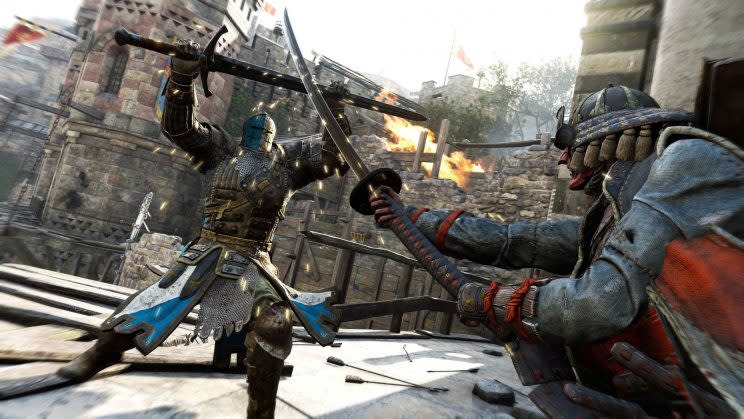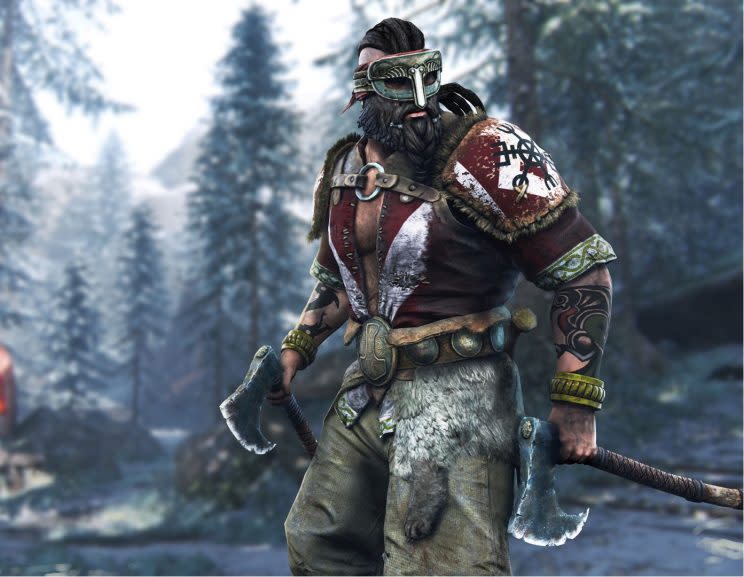'For Honor' review: You'll need skill to survive this online fighter

In the two weeks I’ve been playing Ubisoft’s “For Honor,” I’ve vacillated between absolutely loving the online fighting game and wanting to throw my controller through the window in frustration.
That’s not a knock on Ubisoft’s effort, either. In fact, if anything, it’s a compliment.
“For Honor” is unlike any online fighting game I’ve played before. It marries the kind of familiar battle modes found in shooters like “Call of Duty” — Deathmatch, Skirmish, etc. — with an up-close and personal fighting system that forces you to think strategically about every single button press you make.
When everything comes together in your favor and you manage to knock off a handful of opponents with some well-timed blows and blocks, it’s a beautiful experience. But when you mistime your moves, you pay hard. And then you throw your controller through the window.
It’s that moment-to-moment exhilaration, the sense that every battle can change in an instant, that makes “For Honor” such an exceptional game. It’s got some problems — there are a few control issues and a distinct lack of satisfying player rewards for completing matches — but give “For Honor” enough time and this deep multiplayer combat games will give you plenty in return.
The art of battle
“For Honor’s” combat revolves around what Ubisoft calls its “Art of Battle” system. Press the lock-on button, and a three-piece shield appears on screen representing the directions you’re guarding against or attacking from.
Hold the lock-on button and move the right stick to the left, for instance, and your character will get in position to block incoming attacks or swing from the left. There are only two kind of attacks, light and heavy. Seems simple enough, right?

When you get into real-time combat, though, you quickly realize that the tutorial was tee ball and you’re now in the majors. Other players change their stances in the middle of attacks, chain different moves together and force you to react in kind or be cut down in seconds. Sure, you can button mash and get lucky a few times, but this fighting system actually takes skill to use.
At times, though, I noticed my moves didn’t translate to any on-screen action, which resulted in my untimely decapitation. My first few online matches with “For Honor” were awful. That’s because most online games I play include some kind of shooting, which means there’s not much to learn beyond a character’s basic qualities. But “For Honor” forces you to not only learn new characters — there are 12 different “Heroes” to choose from — but a completely new gameplay style, too.
Suffice to say, after about a half hour of playing, I was getting annoyed. But then things started to click. I began to catch up with the other players, and like that, I was carving people up with glee.
TL;DR: there’s a steep learning curve here, but it’s well worth it.
Vikings, samurai and knights, oh my
Three factions populate the world of “For Honor”: Vikings, Knights and Samurai. Does it make sense? No. Does it matter? Not a bit. A decent single-player experience pitting you against different warlords and their one-shot-kill minions adds context, but this isn’t “Titanfall 2.” You’re not missing anything if you pass on the campaign.

When you first fire up “For Honor” you choose one of the three factions to support in the game’s overarching Faction War. Choosing a specific faction doesn’t limit which of the three groups you can play as during games, though. For instance, I chose the Knights, because that was my high school mascot and I peaked long ago, but regularly played as the Viking faction’s Berserker.
At the end of each online match, you receive war assets that you can place on a global map to help influence the broader Faction War. At the end of each 10-week season, every player in the world gets a reward depending on how their faction performed.
I never found the Faction War to be very compelling, though, and usually just spent my war assets at random. The slow drip of items for participating in the war isn’t enough of an incentive, however; speeding the awards up would have given me more urgency to play along.
Everyone’s a little different
Each of the fighters in “For Honor” has their own specific traits. For instance, the Berserker carries two hatchets and moves and dodges quickly, but doesn’t pack much of a punch. The Knight’s Conqueror carries a flail and shield that’s great at taking on players that constantly block. Then there’s the giant Samurai Shugoki, a mountain of a fighter that’s preposterously slow, but crushes you with each brutal swing of his club.

Fighters also get four customizable special Feats that you unlock by earning Renown, which you gain by killing enemies or reviving teammates. As you level up each character, you unlock more powerful Feats that, for instance, let you heal teammates or throw firebombs.
Interestingly, none of “For Honor’s” characters seem to perform better than others on specific maps, so which fighter you choose depends on the mood you’re in. Unfortunately, you can’t switch fighters in the middle of a match, which is a huge letdown.
After each match, you receive steel and, occasionally, new weapons or armor. Ubisoft did a surprisingly good job ensuring that none of the items are too overpowered, so you won’t have to worry about picking up the game for the first time and being annihilated by someone with an absurdly powerful axe.
A number of weapons and armor I’ve received provide bonuses for what’s called Revenge mode, which is a kind of last stand state that boosts your attack and defense when you dole out a certain number of hits or block a set amount of attacks. But even those won’t give one player an enormous advantage over others.
Battle on
“For Honor” delivers 12 multiplayer maps and a handful of game modes, ranging from 2v2 Brawls to 4v4 Dominion. Brawl is the most basic and sees you and a teammate battle against two real or AI opponents (without Feats) in a best-of-5 challenge.

Skirmish is a 4v4 fight to 1,000 points, while Dominion is a capture-the-flag game to 1,000 points. At the end of both Skirmish and Dominion, you’ll get one last chance to kill an entire enemy team. There’s something animalistic about hunting down that last remaining player that cuts right to the heart of the brutality of “For Honor.”
And brutal it is. Killing enemies with heavy attacks lets you perform executions, like cutting off heads or breaking backs, that prevents them from being revived and adds to their respawn penalty timer.
I do have one complaint about “For Honor’s” multiplayer, and that’s the fact that, while there’s always one orange and one blue team, they change constantly. So if you start a round on the blue team and move on to another round, you could be placed on the orange team. That’s a problem because if you’ve become acclimated to fighting anyone that’s orange in one round, you’ll probably start attacking your teammates when you’re placed on the orange side in the next round.
Fight or flight
“For Honor” is a genuinely exciting game with an inventive battle system that feels like you’re actually matching wits and skill with other players. The characters are unique and the tenor of a fight can change with the flick of a joystick. And while Faction War seems like a missed opportunity, the battles always feel new and fresh. Despite a few hiccups, this is a fight worth having.
Platform reviewed: PlayStation 4

What’s hot: The Art of Battle fighting system requires real skill; unique fighters; intense battles
What’s not: Faction War is a missed opportunity; steep learning curve; can’t switch fighters mid-match
More games news:
‘Horizon: Zero Dawn’ Review: Combat and storytelling shine in spectacular sci-fi epic
The $450 Analogue Nt mini brings new life to old-school NES games
